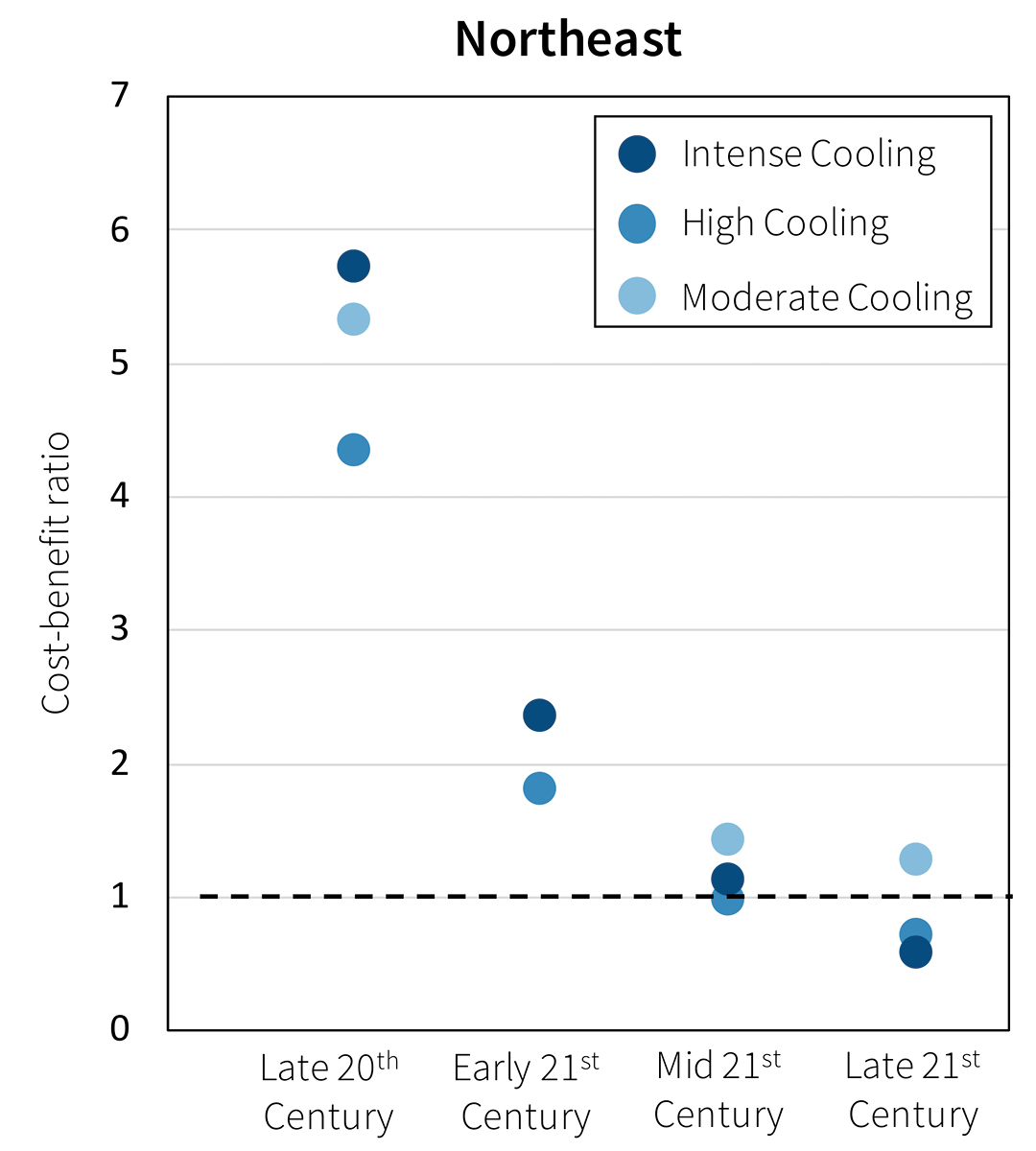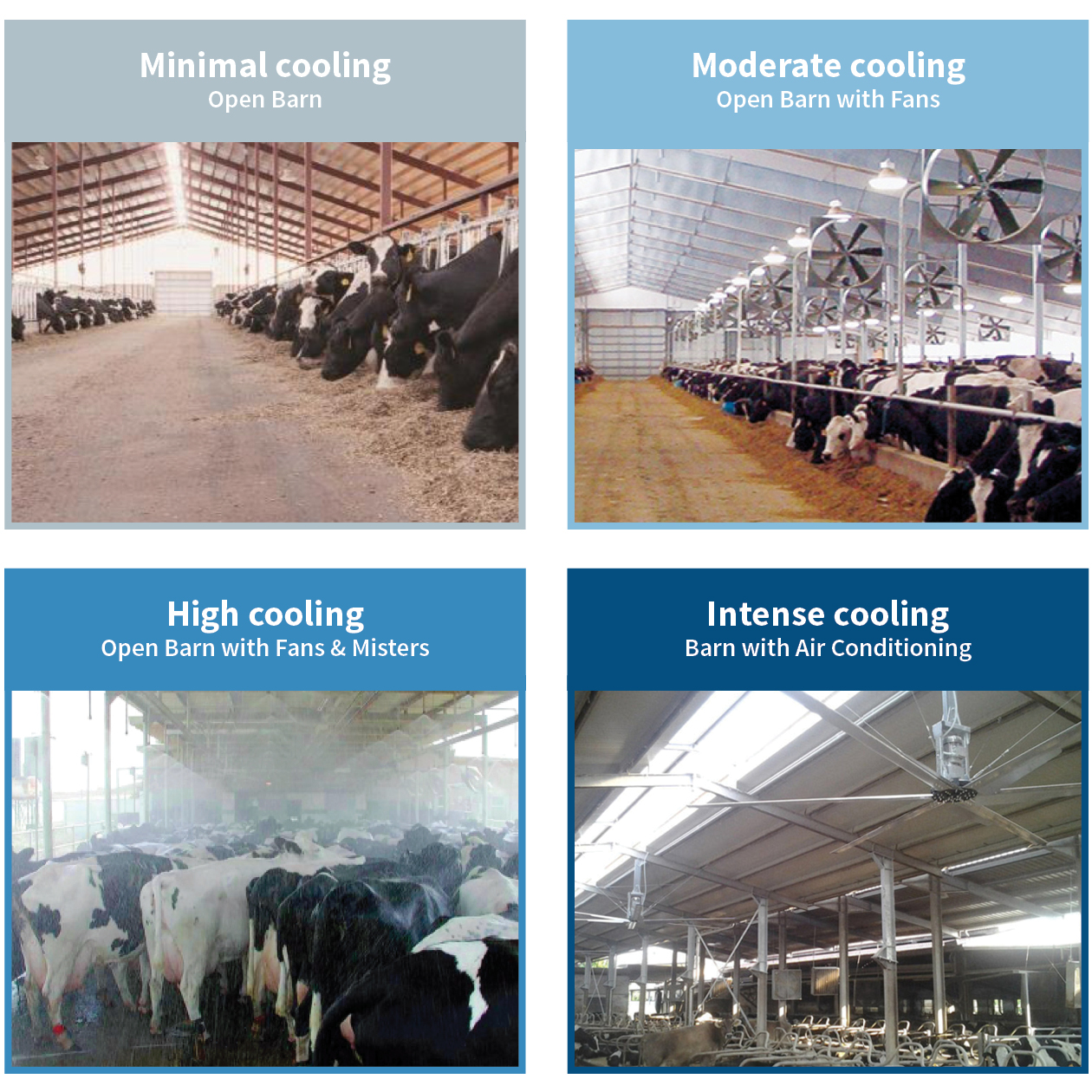Keeping cows cool in the summertime is a major concern for dairy farmers, even in the relatively moderate climate of the Northeast. During humid heatwaves, temperature and humidity levels can rise above a cow’s comfort zone, leading to heat stress.
When heat stress occurs, dairy cows will typically eat less food, have difficulties with calving, and produce less milk. Reduced milk production with heat stress is concerning given the dairy industry’s economic value to agriculture in the Northeast (Winsten et al., 2010). In the abnormally hot summer of 2005, for instance, dairy heat stress reduced milk production on some New York dairy farms by as much as 20% (Frumhoff et al., 2007).
Across the Northeast, temperature and humidity levels continue to rise with climate change (Grotjahn and Huynh, 2018), and these trends are expected to adversely affect dairy production in the near future (Frumhoff et al., 2007). Indeed, many northerly locales are already seeing heat stress occur with greater regularity (Polsky and von Keyserlingk, 2018). If the frequency and severity of humid heat waves increases as expected toward the end of this century (Russo et al., 2017; Coffel et al., 2018; Dahl et al., 2019), farmers in the Northeast may even need to adopt cooling strategies for their dairy herds.
Research briefIn a recent publication (Gunn et al., 2019), a team of scientists from USDA-ARS, Auburn University, and Texas Tech University sought to determine how dairy heat stress could be managed in a rapidly warming climate.
To estimate heat stress in dairy cows, the team used the temperature-humidity index, which combines air temperature and relative humidity values into a simple measure of apparent temperature, like the well-known heat index. Heat stress in dairy cows typically occurs when the temperature-humidity index rises above 70 (Key et al., 2014). Using climate model forecasts out to the year 2100, the team estimated heat stress frequency as the number of days each year when the temperature-humidity index exceeded 70. This was done for 36 locations in major dairying areas of the US.
The team also assessed the ability of different cooling strategies to lower the temperature-humidity index and reduce the frequency and intensity of heat stress. Four increasing levels of cooling were considered (St-Pierre et al., 2003), including: (1) minimal cooling with an open barn, (2) moderate cooling using an open barn equipped with fans, (3) high cooling using an open barn furnished with fans and misters, and (4) intense cooling using an air conditioned barn. The team then conducted a simple cost-benefit analysis to determine when such strategies might become economical.
Maps showing the population density of dairy cows in the US (left) and the 36 locations that were modeled in each of nine regions in the US (right)

The cost-benefit ratios for moderate, high, and intense cooling for early (2015–2034), middle (2045–2064) and late (2081–2100) twenty-first century. Cost-benefit ratios weighed the marginal profit that was gained from each level of cooling (benefits) against the costs of implementing that level of cooling (costs). Cost-benefit ratios that were equal to or less than one were considered economical (left). Images showing the four different cooling levels that were modeled (right).


Trends in heat stress frequency for four representative dairying locations in the Northeast from 1980–2100. Predictions of heat stress frequency are based on climate model output that assumes a business-as-usual (a.k.a. high) emissions scenario for greenhouse gases. Heat stress frequency was estimated as the number of days each year when the temperature-humidity index exceeded 70.

Trends in heat stress frequency for four representative dairying locations in the Northeast from 1980–2100. Predictions of heat stress frequency are based on climate model output that assumes a business-as-usual (a.k.a. high) emissions scenario for greenhouse gases. Heat stress frequency was estimated as the number of days each year when the temperature-humidity index exceeded 70.
In the Northeast, heat stress was not much of an issue under the current climate, but was expected to worsen with future climate change.
Across four key dairying locations in the Northeast, heat stress averaged about 27 days per year under late-twentieth century (1981–2000) climate conditions. In warmer regions to the south, heat stress conditions were up to five times more frequent, averaging as much as 140 days per year.
As a result, investing in added cooling measures did not appear to make economic sense for most dairy farmers in the Northeast. By the middle and latter portions of this century, heat stress frequency was expected to rise significantly in the Northeast, with each decade seeing roughly 8 more days of heat stress than the decade before. These increases in heat stress occurrence were notably faster than many of the southerly regions where heat stress is already a common problem. By the end of this century, study results suggested that the frequency of heat stress in the Northeast could resemble present-day heat stress conditions in southern regions of the US. If these trends were to hold, then additional cooling interventions may be warranted.
Findings from the study suggested that dairy farmers could minimize milk production losses by adopting cooling strategies for their dairy herds. The team found that high, and in some cases, intense cooling strategies may become necessary to ease longer stretches of heat stress that are likely to occur later this century. Simple cost-benefit analyses also indicated that high and intense levels of cooling could potentially be economic for some dairy farmers to implement. In sum, while climate warming is expected to bring increasing challenges to dairy farmers in the Northeast, there is great potential to mitigate some of these challenges with various cooling measures.
Further Reading
Climate change, heat waves, and humidity:
- Climate change has increased humidity in D.C., making it feel even hotter
- Heat and Humidity are a Deadly Combination
- Summers Getting Muggier As Dewpoint Temp Rises




